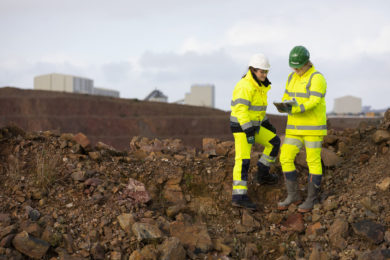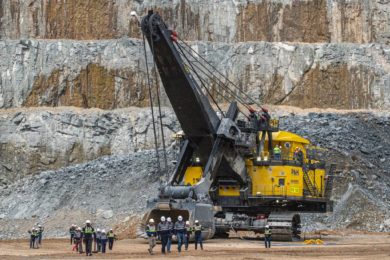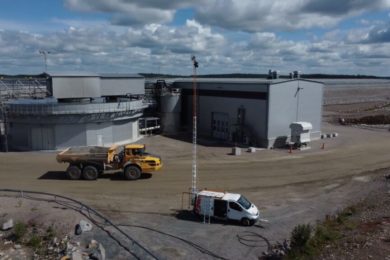An updated feasibility study on Tungsten West’s Hemerdon project in Devon, England, has brought with it a processing re-optimisation program that includes a complete redesign of the front-end crushing circuit at the mine, a process that, it says, will considerably reduce the capital expenditure associated with this development.
The new study outlined average annual production of 2,900 t of WO3 in concentrate and 310 t of tin in concentrate over a life of mine of 27 years, along with an average steady-state mining rate of 3.5 Mt/y.
The changes to the existing process flowsheet to be implemented at Hemerdon can be categorised into three areas, namely:
- Front end upgrades – new crushing, screening and ore sorting circuit required for Phase 1 (average of 2.4 Mt/y of granite ore, years 1-2);
- Existing minerals processing facility modifications – upgrades to existing plant to accommodate production requirements for Phase 1; and
- Phase 2 (3.5 Mt/y of granite ore, year 3 onwards) crushing and process plant expansion – future upgrades to both crushing and processing plants required for increased production rates, envisaged from year three onwards.
The re-engineering has mainly reduced capital and operating expenses around reduced ore handling costs by the introduction of direct tipping at a newly sited run of mine pad, incorporating the introduction of new semi-mobile primary jaw and secondary cone crushers, new operating parameters for the ore sorting circuit, and, to a lesser extent, changes to the existing dense media separation and fine gravity dressing circuits.
The revised front-end design also includes a significant tactical advantage through the introduction of a secondary crushed ore stockpile ahead of the ore sorters, Tungsten West said. This provides up to circa-40 hours of redundancy capacity to the crushing circuit, thereby de-coupling the front end crushing circuit from the minerals processing facility (MPF) – minimising downtime and maximising availability of the concentrator circuit.
Tungsten West has maintained the ethos of the original feasibility study in continuing to engineer-out as many operational, mechanical, electrical or ESG issues associated with the previous operation as possible and to ensure MPF availability and operability remains a priority, it said.
Back in July, Tungsten West concluded a re-evaluation of the options for bringing the Hemerdon mine back into production, announcing a new development plan that would re-optimise the March 2021 Bankable Feasibility Study. The plan was developed in response to global crises in power and diesel prices and the general inflationary environment for construction materials faced by the company.
The new plan has resulted in a remaining capital expenditure, including EPCM fees, of £31.1 million ($38 million) as of October 1.
Mark Thompson, Executive Vice Chairman of Tungsten West, said: “The feasibility study provides solutions to the energy price challenges and will enable increased operating efficiencies at the project. Key highlights from this study include a revised ore delivery and waste mining strategy, a split-phase approach to operational ramp-up to the full design specification, a new primary and secondary crushing method and location, a re-optimisation of the operating strategy for the X-ray Transmission ore sorters, re-design and re-engineering of the feed preparation, ore sorter buildings and structures, and a re-evaluation of the operation of unit processes and expected recoveries.
“We are build-ready at Hemerdon and we look forward to continuing to work with our partners and stakeholders to bring Hemerdon back into production in the fourth (December) quarter of 2023.”










